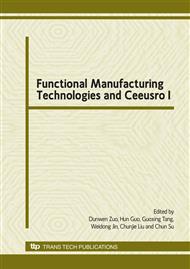p.49
p.55
p.60
p.65
p.70
p.75
p.81
p.85
p.89
Study on the Kinematics of the Lips of the Twist Drill on the Axial Vibration Part 1: Axial Locus and Vibration Pattern
Abstract:
Loci were studied of the lips movement with axial vibration for both non-disjunction and dis-junction pattern of the twist drill, with the proof that for the dis-junction pattern the chip might be broken by the special loci of the lips without any additional external forces. Positions of the same two points on the two major cutting edges were presented in detail with the rotation angle between the two points, 180 deg. Difference of the two loci, h, was the chip thickness that altered instantly and when it was zero the chip broke. Minimum difference hmin was taken as a criterion for vibration drilling pattern. Non-disjunction pattern of vibratory drilling came out when hmin >0 and disjunction pattern arrived otherwise. Expressions for the two patterns showed that vibratory parameters and cutting parameters have influenced h considerably.
Info:
Periodical:
Pages:
70-74
Citation:
Online since:
January 2010
Authors:
Keywords:
Price:
Сopyright:
© 2010 Trans Tech Publications Ltd. All Rights Reserved
Share:
Citation:


